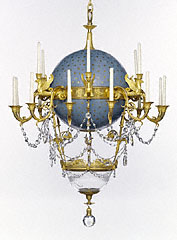• The artist was inspired by a new mode of transportation when designing this chandelier.
Look carefully at the shape of it. What do you think was the basis of his inspiration?
(The hot air balloon, invented 35 years earlier, and introduced to the world from Versailles under
Louis XVI,
is the inspiration for this chandelier. The star globe is the balloon, with a glass basket suspended from gold tethers.)
• Can you identify the materials used in this chandelier? (Glass/crystal, gold/gilt bronze, enameled metal. Gilt bronze is a thin layer of bronze fused on to the metal base to look like gold. Enamel is an opaque glassy coating fired-on on to the metal.)
• Describe the
motifs, or designs, found on this object. (Stars, eagles, foliage,
griffins, hot air balloon,
floral garlands, zodiac signs, arabesques (intricate patterns of interlacing lines derived from Islamic ornamentation), curlicues.)
• Is this work of art symmetric, asymmetric, or radially symmetric? (Radially symmetric. All sides of the
chandelier radiate out from the central globe.)
• In what type of room do you think this chandelier was used? (Possibly a grand and elaborately decorated
room used for entertaining guests.)
• This chandelier has been interpreted as symbolizing the four elements of earth, fire, water, and air.
Where do you see these elements represented? (Earth is represented through the foliage. Fire is represented
in the candles. Water is symbolized by the fishbowl. Air is seen in the hot air balloon and flying griffins.) |
In the 19th century, recent advances in travel via the hot air balloon and the renewed interest in exploration
inspired the design of this fanciful chandelier with a blue enameled globe strewn with gold stars above a glass bowl.
The globe is meant to convey a sense of the heavens, further enforced by the 12 signs of the zodiac applied around it
on a gilt-bronze band. Also encircling the globe are candleholders in the form of foliage and ancient mythical creatures
know as griffins. The bowl is decorated on its gilt-bronze rim with floral motifs and eagles clutching lightning bolts
and has garlands etched into the glass. A bronze plug in the bowl is decorated with
classical motifs of
palmettes, arabesques, and
acanthus leaves. When the artist exhibited the chandelier in 1819, he described it as a
lustre à poisson (fish chandelier), referring to the bowl, which was to be filled with water and goldfish.
The continuous movement of the fish and the reflection of the candlelight on their bodies, the water, and the draped
crystals were meant to amuse and entertain the work's owner and his guests. This chandelier can also be seen as an
allegory of the four elements: earth is represented by the gilt-bronze floral motifs, fire is represented by the flames
of the candles, water is represented by the bowl and the crystals, and air is represented by the balloon and flying griffins.
Gérard-Jean Galle tried to sell this chandelier along with other merchandise to the French king Louis XVIII in 1820.
Conscious of popular criticism of frivolous governmental expenditures (a criticism that had helped to fuel the French Revolution),
the bureaucrats argued that they could not purchase objects that were neither "advantageous nor useful."
About the Artist
Gérard-Jean Galle, 1788–1846
French
Although he won several awards for his cast and gilded bronze works, Gérard-Jean Galle never prospered.
Born into a French family of casters and gilders in 1788, he probably received his training in the workshop of
his father, Claude Galle, also a bronze caster, who produced objects for Marie-Antoinette, Queen of France, wife of Louis XVI.
Upon the death of his father in 1815, Galle took over the family workshop. During this period of political
upheaval in France, money was in short supply, and few of the wealthy were willing to spend it on luxury
products such as gilt bronze. In 1819 Galle entered some of his designs in the Paris Exposition des Produits
de L'Industrie Française (Exhibition of French Products of Industry) and won a silver medal. Despite this
recognition of his talents, he was still unable to sell his works. He therefore made a desperate plea to the
newly restored monarch. In a letter to the court, Galle explained that his goods were "the cause of the ruin
of my workshop and my family" and offered them to the king for a sum that would be "modest for the government."
His offer was refused, but several years later Galle was given the title fournisseur de sa majesté
(Supplier to the King).
The revolution of 1830 worsened the economic situation, and Galle again suffered. He was forced to halve
the size of his workshop and died in poverty in 1846.
|

